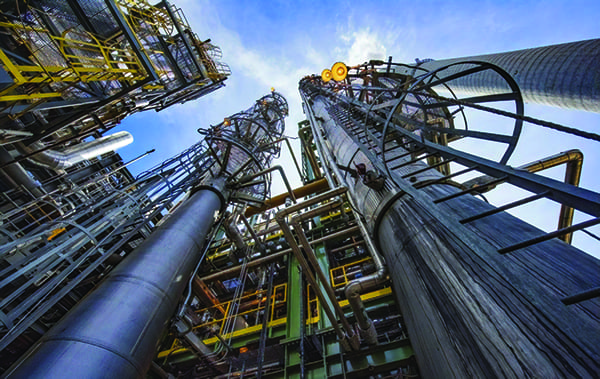The Middle Ground: The Role of CCS After COP26

We hear calls for the elimination of fossil fuels" as the primary solution to climate change, those calls coming from investors, institutions, governments-and from many world leaders and others gathered at COP26 in Glasgow, Scotland.
COMMENTARY
As we begin to experience the outcome of recent energy policies that focus on the buildout of renewables capacity, while actively discouraging oil and gas production and development of energy infrastructure such as pipelines, and also advocating for nuclear power shutdowns, greenhouse gas emissions are likely to increase dramatically alongside energy and food prices.
As the energy demands from a global population of more than 7.7 billion people relentlessly increase, dangerous shortages of energy are developing, and gaps in supply will be met with increased use of coal, which is the most carbon-intensive energy source.
Understanding fundamental truths about energy and carbon emissions is critical; ignoring or wishing away the challenges will result in energy crises, higher emissions, social challenges and ultimately, no policy durability.
The Carbon-Affordability-Reliability FrameworkThe Carbon-Affordability-Reliability (CAR) framework is a model to inform the inextricable trade-offs we are bound to in making energy policy choices. As an example, solar panels and wind turbines are very good in terms of carbon dioxide (CO2) emissions and affordability; however, solar panels and wind turbines are utterly unreliable. Adding storage to manage this unreliability increases costs, increases CO2 emissions, and only solves reliability for several hours.
 Craig Golinowski
Craig GolinowskiBy contrast, natural gas-fired power with carbon capture and storage (CCS) allows for significant reductions in CO2 emissions, a known increase in costs and full reliability as the power is baseload and dispatchable.
The value and importance of reliability can be thought of in the following way-what is the sum of all the personal and business activities that would have to be suspended during a day if power is not available, if jet fuel is not available, if gasoline and diesel are not available? Ranging from mere inconvenience to life-or-death, trading away energy reliability for CO2 emissions is a bad bet and will not stand the test of time as a durable policy.
Technology advances will assist in reducing the distance between carbon intensity, affordability, and reliability. Advances in battery storage, managing fugitive methane emissions, and carbon capture and storage are all examples of decreasing energy system trade-offs.
There is no energy technology silver bullet." The tens of thousands of engineers who work in the energy system day in, day out, have not missed the silver bullet." Progress is measured linearly and painstakingly over years in small but steady advances. Moore's law does not apply to advances in the physical energy system. Believing otherwise is both ignorant and arrogant.
Ignoring Energy Reliability is Wrong, and Results in the Carbon ParadoxCalifornia, Texas, and Europe have provided recent demonstrations of the consequences of wishing away energy reliability challenges directly caused by renewables and insufficient hydrocarbons. In Texas last winter, people died from a calamity of facing adverse weather with insufficient energy.
Adverse weather can impact renewables production at the same time as when demand is at its highest. During adverse weather, the gap in supply and demand can be huge, which can cause cascading failures across our civil and social systems. As we add more renewables and retire baseload energy, we become more vulnerable to even normal adverse weather events.
In the UK this autumn, wind power production in the North Sea was significantly below average during August and September, and the natural gas system was the only scalable system capable to respond. Coal-fired power in the UK has been substantially decommissioned since 2012. Unfortunately, natural gas storage has not been refilled as customers in Asia are demanding LNG to refill energy storage. If Europe faces a normal to cold winter, the energy system will be under enormous stress, and will respond by increasing consumption of coal and petroleum alongside shutdowns in industry to limit grid failure and peril.
The Carbon Paradox raises its ugly head. The Carbon Paradox is the tendency for gaps in supply and demand for energy to be met with the highest carbon-intensity energy choice. The reason is because the highest carbon-intensity energies are the easiest and cheapest to store. A pile of coal or a tank of diesel essentially costs nothing to store the energy. In a crunch, coal, diesel and other low-technology" fuels are always going to be used because cascading failure of the grid is an unthinkable alternative. Coal is twice as carbon-intensive as natural gas and 16x more intensive than solar. Ignoring reliability simply means emissions happen anyway.
China's electricity grid is nearly 2.5x more carbon-intensive than the grid in Europe. If energy system choices result in industrial production moving to China, emissions will increase. Again, if reliability and affordability are ignored, emissions increase.
With a problem so large and complex as energy and emissions, we need to avoid simplistic and incorrect solutions, like divesting from oil and gas, which will have a direct impact on the economy and people's lives. That decision, made by some of the smartest" and well-respected institutions in the world. will end up having a severe impact on populations worldwide. We wholeheartedly agree with recent comments from Blackstone's Stephen Schwarzman that the global energy crisis so severe it can cause social unrest.
Carbon capture and storage offers a radical middle" solution wherein long-time investments into oil and gas production and infrastructure are paired with long-term storage for emissions. We maintain energy affordability and reliability while directly managing the greenhouse gas emissions associated with hydrocarbons. Energy carriers, like electricity, hydrogen and ammonia, are enabled by carbon capture and hard-to-abate industrial sectors like cement, steel, and fertilizer production can reduce emissions when equipped with carbon capture.
Ironically, as the current energy supply crises progress and become more acute in the coming years, governments, investors, and institutions are likely to be forced to turn a 180, and create policy certainty to encourage oil and gas producers to make long-term investments in new supply and infrastructure.
-Craig Golinowski is Managing Partner of Carbon Infrastructure Partners.
The post The Middle Ground: The Role of CCS After COP26 appeared first on POWER Magazine.